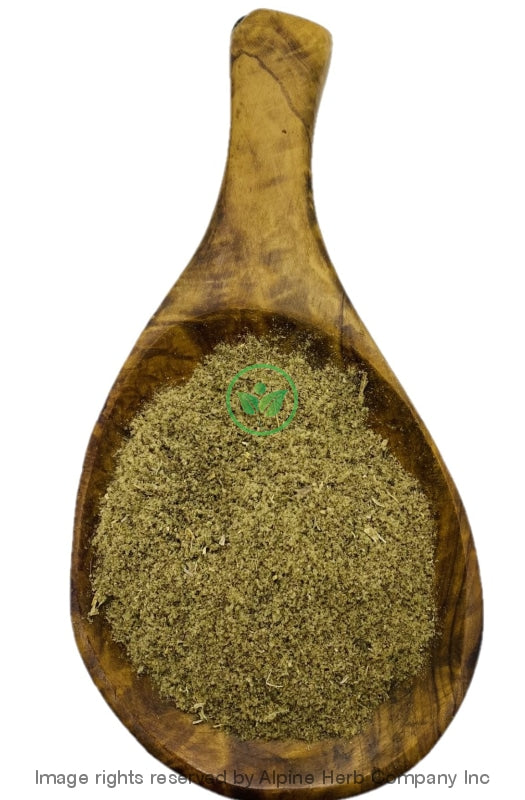Mullein Leaves Powder Alpine Herb Company Inc.
$ 9,99 $ 5,99
Botanical Name: Verbascum thapsus
Common Name:
- English: Cow’s Lungwort, Common mullein
- Ayurvedic: Ban Tambaaku, Gidar Tambaaku, Phullaa
- Also, known as: Candle wort, Aaron’s rod, Wollkraut, Bouillon Blanc, Gordolobo, Candela regia, Busir, Makizahraj, blanket herb, velvet dock, Shepard’s club, old lady’s flannel, bullock’s lungwort, White Mullein. Torches, Mullein dock, Velvet Plant, Woollen. Rag Paper, Candlewick Plant, Wild Ice Leaf. Clown’s Lungwort. Bullock’s Lungwort. Aaron’s Rod, Jupiter’s Staff, Jacob’s Staff, Peter’s Staff, Shepherd’s Staff, Shepherd’s Clubs, Beggar’s Stalk, Golden Rod, Adam’s Flannel, Beggar’s Blanket, Clot, Cuddy’s Lungs, Duffle, Feltwort, Fluffweed. Hare’s Beard, Old Man’s Flannel, Hag’s Taper
Harvested: Wild
Parts Used: Leaves
General Information:
Mullein is a biennial plant native to Europe, where it is found on hillsides and open land. The plant likes full sun and reaches a height of about 6 feet (2 meters). The leaves are large, soft and velvety green. The flowers are yellow and grow in clusters. Mullein is also known as velvet plant, flannel flower, blanket herb, and felt wort.
The Great Mullein, is a widely distributed plant, being found all over Europe and in temperate Asia as far as the Himalayas, and in North America is exceedingly abundant as a naturalized weed in the eastern States. It is met with throughout Britain, and also in Ireland and the Channel Islands, on hedge-banks, by roadsides and on waste ground, more especially on gravel, sand or chalk. It flowers during July and August the natural order Scrophulariaceæ is an important family of plants comprising 200 genera and about 2,500 species, occurring mostly in temperate and sub-tropical regions, many of them producing flowers of great beauty, on which account they are frequently cultivated among favorite garden and greenhouse flowers.
How to use:
Powdered Herb:
There are different ways to use powdered herb.
Food Preparation: You can add powdered herb to any super food herbal smoothie, sauces, spreads and even cookies. Also for children, you can mix powdered herb with honey or glycerin to make paste. The thicker the paste, the more potent and herbal in taste. The sweet taste of honey and glycerin will help medicine go down. This method is also known as “Electuaries”.
Capsules: Encapsulating your own powdered herb at home, gives you assurance that the contents of the capsules are pure herb and no filler or any other products. These capsules can be taken with liquid.
Poultice: Poultice can be made with an herbal powder and liquid (mostly water) to form a paste which is then applied to the skin. This method is very helpful for skin conditions.
Herbal shot: Powdered herb can be mixed with water, fruit juice or other liquid to make herbal shot.
Precautions:
You should consult with a qualified healthcare practitioner before using any herbal products, particularly if you are pregnant, nursing, or on any medications.
All information on this website is for educational purpose ONLY
This information has not been evaluated by Health Canada.
This information is not intended to diagnose, treat, cure, or prevent any disease.
| Unit Size | 100g, 200g, 400g, 1kg |
|---|
Prompt shipping and expert packing
Thanks to our longstanding association with UPS FedEx DHL as well as other leading global carriers, we can offer a variety shipping options. Our warehouse staff is highly trained and will be able to pack your goods in accordance with our precise and exact specifications. Your items will go through an exhaustive examination before they will be securely packaged before being delivered. We ship to hundreds of thousands of customers daily in different countries. This is a sign of our determination to become the largest online retailer worldwide. Warehouses and distribution centers are located throughout Europe as well as in the USA.
Note that orders containing multiple items are processed according to the particular item.
We will thoroughly inspect all items ordered before shipping. Most orders are shipped within 48 hours. The delivery time will be between 3 and 7 working days.
Returns
The stock market is always changing. It's not entirely managed by us since we're involved with several entities, including the factory and the storage. Therefore, the actual inventory could fluctuate at any moment. Please be aware that it is possible that your order could be out of stock after you've placed your order.
Our policy lasts for 30 days. If it's been more than 30 days since the date you purchased your item We're sorry to say that we can't offer you a full exchange or refund.
You can only return a product if it is unused and still in the same state as when you received it. The item should be in the original packaging.
Related products
Herb Powder
Herb Powder
Herb Powder
Herb Powder
Herb Powder
Herb Powder
Herb Powder
Herb Powder
Herb Powder
Herb Powder
Herb Powder
Herb Powder
Herb Powder
Herb Powder
Herb Powder
Herb Powder
Herb Powder
Herb Powder


































